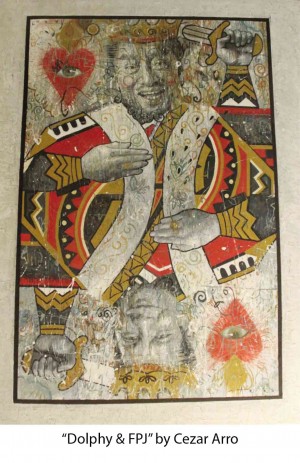What becomes a legend most?
So goes a famous advertising campaign for a fashionable mink fur, Blackglama, which featured some of the most famous faces in the movie firmament, from Bette Davis down to Sophia Loren and Janet Jackson. The campaign ran for years and was proclaimed “one of the most iconic advertising campaigns in America.”
So there’s that other word, “iconic,” which has gained such currency that celebrities, already in that rarefied media status, still strive to arrive at that higher level of esteem and adulation. Of course, to be “iconic” is to be way beyond the so-called “cult of celebrity” which has been defined as “famous for being famous”—as exemplified by the likes of Paris Hilton and the Kardashian sisters.
On view at Galerie Anna is Cezar Arro’s 3rd solo show, “Eye.Con,” which, aside from being a play on the word, intends to convey a deeper meaning by alluding to conversation and communication. Indeed, he adverts to a universal consciousness of certain distinct individuals who have symbolized their own fields, whether in cinema, science, art, music, politics and technology. Arro’s recent works have been centered on the examination of the human face emerging from a multitude of abstract markings and gestural brush strokes. These faces, dolorous and forlorn, despairing and ruminative, lost and uncertain, gaze out from underneath the barrage of pigments, assuming the nature of mirage and apparition. Disembodied and dematerialized, these paintings are distinguished by a pair of disconcerting eyes, by turns wild and still.

The word “icon” (or ikon) has evolved from its original meaning, which is the representation of religious personages worshipped in the Byzantine and other Eastern churches. Today it is better understood as a famous personage representing a field of endeavor or as a symbol of an era, transcending mere fame, notoriety (such as Hitler and Stalin) or celebrity, such as Marilyn Monroe or John Lennon. In fact, a measure of being iconic is instant recognition by the use of a single name, such as Garbo, Picasso, Dali, Hitchcock, or Warhol. The word “icon” has also evolved as every tech savvy person knows, into the computer symbol meaning “a picture on the screen that represents specific file, directory, window or program.”
Familiar
Arro’s choice of icons are so familiar from excessive exposure in the media that they run the risk of mutating into a still unspecified species of fame. What differentiates his works is the witty and playful subsuming of these icons, engulfed by the specter and avalanche of paint as matter and substance, from whence emerge the familiar face. When up close, the viewer grapples with an abstract vision. At some distance, he is rewarded by a sight of recognition, stimulated by the visual trickery. Interestingly, each iconic face is a brand unto itself, with a distinctive feature—Dali’s upswept moustache, Monroe’s half-opened seductive mouth, Warhol’s silver wig—that is the cartoonist’s delight.
Arro seizes on the playing cards and picture frames as a device to present reversible imagery in the depiction of King, Queen and Jack. Perfect is the pairing of local icons Dolphy, King of Comedy and FPJ, King of Action. Queen is Freddie Mercury of the famous group. King of Pop, Michael Jackson is paired with Andy Warhol, Pope Pop Art. Initially riding on the fame and glamour of his subjects, i.e. Monroe, Liz Taylor, Jacqueline Kennedy, Elvis Presley, Warhol himself became an icon. Da Vinci smiles up or down at his most famous creation, Mona Lisa. Van Gogh dreams of his “Starry Night.” Frida Kahlo is reversible as male and female version of herself. Darwin, author of “Origin of Species” is kept company by the supposed origin of mankind, the evolving ape. Royalty rears its crowned head in the persons of the Queen of England and the late Princess of the People, Diana—the last reminding us ordinary mortals that the lives of some of these icons ended tragically or controversially.
These individuals are immuned from the Warholian “fifteen minutes of fame.” Indeed, they are all timeless, and in these portraits of Cezar Arro, they only serve, in the words of the poet-playwright Jean Cocteau, “as a model for the portrait of our fame.”